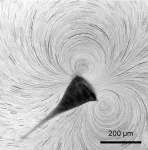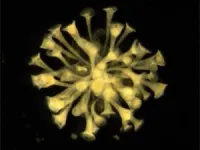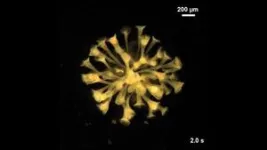(Press-News.org) Life emerged on Earth some 3.8 billion years ago. The “primordial soup theory” proposes that chemicals floating in pools of water, in the presence of sunlight and electrical discharge, spontaneously formed organic molecules. These building blocks of life underwent chemical reactions, likely driven by RNA, eventually leading to the formation of single cells.
But what sparked single cells to assemble into more complex, multicellular life forms?
Nature Physics published a new insight about a possible driver of this key step in evolution — the fluid dynamics of cooperative feeding.
“So much work on the origins of multicellular life focuses on chemistry,” says Shashank Shekhar, lead author of the study and assistant professor of physics at Emory University. “We wanted to investigate the role of physical forces in the process.”
Shekhar got the idea while watching the filter feeding of stentors — trumpet-shaped, single-celled giants that float near the surface of ponds.
Through microscope video, he captured the fluid dynamics of a stentor in a liquid-filled lab dish as the organism sucked in particles suspended in the liquid. He also recorded the fluid dynamics of pairs and groups of stentors clumped together and feeding.
“The project started with beautiful images of the fluid flows,” Shekhar says. “Only later did we realize the evolutionary significance of this behavior.”
Shekhar and his colleagues discovered that grouping together benefits a stentor colony as a whole by generating more powerful flows to sweep in more food from a greater distance away.
The stentor’s multicellular-like behavior could be used as a model system to help understand how life evolved from single-cell organisms to complex organisms like humans — made up of trillions of cells with specialized tasks.
Co-corresponding authors of the paper are John Costello, a marine biologist at Providence College in Rhode Island and Eva Kenso, a mathematician in the Department of Aeorospace and Mechanical Engineering at the University of South California, Los Angeles.
The project began in 2014 when Shekhar participated in the physiology program at the Marine Biological Laboratory (MBL) in Woods Hole, Massachusetts, an international center for research and education in biological sciences. Shekhar has since held a visiting position at MBL
“Renowned scientists come there every summer from around the world for organic collaborations," Shekhar says of the MBL. "You have the time and resources to explore extreme questions that capture your interest.”
Shekhar drew particular inspiration from three scientists who became his co-authors on the Nature Physics paper. Costello and Sean Colin (a marine biologist from Roger Williams University) study the biomechanics of marine creatures like jellyfish and zooplankton. Wallace Marshall (a cell biologist from the University of California, San Francisco) uses the stentor as a model organism to explore phenomenon like regeneration — for example, the ability of an octopus to regrow a leg.
“You can chop up a stentor and each tiny piece will become a complete organism within 12 hours,” Shekhar says. “They are fascinating in many ways.”
These single-celled eukaryotes, common in freshwater ponds and streams, are named after the mythological Greek herald Stentor, due to their horn shape.
At the narrow end of the stentor is a gripping mechanism known as a “holdfast” which allows the organism to anchor to a twig, leaf or other organic matter floating in water. The wide end of the stentor is essentially a giant mouth rimmed with hair-like cilia. The cilia beat in the water, generating currents that drive food particles, such as bacteria or algae, into its mouth.
Stentors can secrete a kind of goo from their holdfast end. This goo enables them to stick to organic surfaces and temporarily form into colonies that take on a half-hemisphere shape.
Perhaps the most remarkable thing about stentors is their size. Most human cells are at least 10 times smaller than the width of a human hair. A single-celled stentor, however, is visible to the human eye at about 1-to-2 millimeters long — the widths of the tip of a sharpened pencil or crayon.
The size of stentors makes it easy to record detailed imagery of their behaviors under a microscope.
Shekhar decided to investigate the fluid dynamics involved in the filter feeding of stentors. He first focused on a single stentor, from the species Stentor coeruleus, attached to the surface of a fluid-filled lab dish.
“I added micron-sized plastic spheres to the liquid to see what would happen,” he says.
The tiny, plastic particles served as tracers, making the flows generated by the stentor’s cilia visible. Shekhar captured striking time-lapsed video of twin vortices forming around the mouth of the stentor.
Shekhar wondered if the behavior of stentors to occasionally form pairs or colonies was related to their quest for food.
To test the idea, he videoed the fluid dynamics of pairs of stentors. Their heads swayed towards and away from one another. “I call that movement ‘I love you, I love you not,’” Shekhar says.
As their heads drew together, the flows generated by the two stentors combined into a single vortex that created a stronger current, able to draw in more particles from a greater distance.
Shekhar wondered why the stentors would move their heads apart since having them together seemed to provide a clear benefit.
A similar behavior was observed in colonies of stentors joined into half-hemisphere-shapes. In this configuration, their heads swayed between an array of adjacent partners and generated flows more powerful than the those of pairs.
Forming colonies seemed to further enhance their ability to suck in particles. So why did individual stentors occasionally break away from a group to swim off on their own?
The researchers theorized that weaker stentors benefitted more from joining forces than the stronger ones.
“The colonies are dynamic as the stentors keep changing partners,” he explains. “The stronger ones are being taken advantage of, in a sense. They change partners often so that everyone benefits similarly.”
The researchers developed mathematical models to test this theory in experimental setups through the expertise of Kanso and co-author Haniliang Guo, a mathematician at Ohio Wesleyan University, Delaware.
The results showed that one stentor always gained more advantage than the other in a paired system. And that forming a large colony, including the dynamic relocation of individuals, enhances the feeding flow rate for individual stentors on average.
The findings provide new insight into the selective forces that may have favored the early evolution of multiceullar organization.
“It’s amazing that a single-celled organism, with no brain or neurons, developed behaviors for opportunism and cooperation,” Shekhar says. “Perhaps these kinds of behaviors were hard-wired into organisms much earlier in evolution than we previously realized.”
The stentor project is a new research direction for Shekhar. His lab is known for uncovering insights into actin — a protein that assembles into filaments in living cells and is essential to their mobility.
“The stentor work was a passion project,” Shekhar says. “It’s wonderful to work at your own pace, over many years, on a question that fascinates you and wind up with such beautiful and significant results.”
END
A new clue to how multicellular life may have evolved
Exploring the fluid dynamics of cooperative feeding
2025-03-31
ELSE PRESS RELEASES FROM THIS DATE:
ALL ALS consortium launches website to advance ALS research
2025-03-31
ALL ALS Consortium Launches Website to Advance ALS Research
The Access for All in ALS (ALL ALS) Consortium announced the launch of its official website, creating a central hub for information about its initiatives and clinical research studies. ALL-ALS.org is designed to inform and engage researchers, clinicians, and current and prospective study participants.
The ALL ALS Consortium formed in fall 2023 with funding from the National Institutes of Health (NIH). The consortium consists of 35 clinical sites in the United States and Puerto Rico, led by researchers at Barrow Neurological Institute in Phoenix, Arizona and Massachusetts ...
Many TB cases may have gone undetected in prisons in Europe and the Americas during COVID-19
2025-03-31
EMBARGOED UNTIL 6:30 P.M. EST on Monday, March 31, 2025
Contact:
Jillian McKoy, jpmckoy@bu.edu
Michael Saunders, msaunder@bu.edu
##
Many TB Cases May Have Gone Undetected in Prisons in Europe and the Americas During COVID-19
A new study found that reported diagnoses for tuberculosis were consistently lower than expected throughout the pandemic, even though incarceration rates remained largely consistent and TB detection among the general population managed to reverse after an early-pandemic decline.
Incarcerated populations have a high risk of developing tuberculosis ...
Predicting older people’s frailty helps doctors intervene earlier
2025-03-31
UNDER EMBARGO UNTIL 00.01 AM BST ON TUESDAY 1 APRIL
The new Electronic Frailty Index 2 (eFI2) is now available to 60% of England’s GPs thanks to research funded by the National Institute of Health and Care Research (NIHR) and conducted by researchers at the University of Leeds and UCL
GP data on 36 health problems such as dementia, falls and fractures will help medical professionals to more accurately identify older people’s frailty and intervene earlier
Interventions may include a holistic assessment and treatment plan, falls prevention, targeted medicines review, and resistance exercise ...
New study validates lower limits of human heat tolerance
2025-03-31
A study from the University of Ottawa’s Human and Environmental Physiology Research Unit (HEPRU) has confirmed that the limits for human thermoregulation—our ability to maintain a stable body temperature in extreme heat—are lower than previously thought.
This research, led by Dr. Robert D. Meade, former Senior Postdoctoral Fellow and Dr. Glen Kenny, Director of HEPRU and professor of physiology at uOttawa's Faculty of Health Sciences, highlights the urgent need to address the impacts of climate change on human health.
The study found that many regions may soon experience heat and humidity levels that exceed the safe limits ...
UTA takes lead with mobile lab to address rural health care crisis
2025-03-31
Texas has the most rural residents of any state, with nearly 3 million people spread across a vast landscape. If rural Texas were its own state, it would rank as the 36th most populous.
Yet, rural Texans face significant barriers to health care that their urban counterparts do not. More than a quarter of the state’s 172 rural counties lack a hospital, and those with at least one hospital often struggle with a shortage of qualified health care personnel, such as nurses and first responders.
To address these growing challenges, The University of Texas at Arlington introduced its new Mobile Simulation Lab on Friday. It’s the first in Texas dedicated ...
New flexible hydrogel could improve drug delivery for post-traumatic osteoarthritis treatment
2025-03-31
Post-traumatic osteoarthritis (PTOA) is a condition that affects joints after an injury. Current treatments focus on relieving symptoms but do not prevent or stop the progression of the condition. Although emerging therapies have shown promise in preclinical studies, a major obstacle is delivering these therapies effectively into the joint, a highly dynamic environment subjected to constant mechanical stress. Researchers at Mass General Brigham have created a new hydrogel to improve drug delivery for treating PTOA. The hydrogel, ...
Association for Molecular Pathology celebrates U.S. District Court’s decision to vacate FDA rule on laboratory-developed test procedure regulation
2025-03-31
ROCKVILLE, Md. – March 31, 2025 – The Association for Molecular Pathology, the premier global molecular diagnostic professional society, and pathologist Michael Laposata, M.D., Ph.D., today announced a favorable ruling in their lawsuit against the U.S. Food and Drug Administration over the regulation of laboratory-developed test procedures. The ruling by Judge Sean D. Jordan of the U.S. District Court for the Eastern District of Texas granted AMP’s motion for summary judgment ...
Dr. Christopher Kramer is new American College of Cardiology President
2025-03-31
Christopher M. Kramer, MD, FACC, today assumed the role of president of the American College of Cardiology, an almost 60,000-member global cardiovascular organization working to transform cardiovascular care and improve heart health for all.
“I see significant challenges and opportunities for the field of cardiology in the coming years, including workforce issues, health equity, diversity and inclusion, and AI-driven solutions, that need to be addressed to achieve ACC’s mission of transforming cardiovascular care for all,” ...
Dr. David Winchester is new Chair of ACC Board of Governors
2025-03-31
Effective today, David E. Winchester, MD, MS, FACC, will serve as chair of the American College of Cardiology Board of Governors (BOG) and secretary of the Board of Trustees. His term will run one year from 2025-2026.
Winchester will lead governors from chapters representing all 50 states, the District of Columbia, Puerto Rico, Canada, Mexico and representatives from the U.S. health services. The BOG serves as the grassroots governing body of the ACC, a leading cardiovascular organization representing over 56,000 cardiovascular care team members around the world.
“Being Chair of the Board ...
4:3 Intermittent fasting shows modestly greater weight loss than daily caloric restriction
2025-03-31
Embargoed for release until 5:00 p.m. ET on Monday 31 March 2025
Follow @Annalsofim on X, Facebook, Instagram, threads, and Linkedin
Below please find summaries of new articles that will be published in the next issue of Annals of Internal Medicine. The summaries are not intended to substitute for the full articles as a source of information. This information is under strict embargo and by taking it into possession, media representatives are committing to the terms of the embargo not only on their own behalf, but ...
LAST 30 PRESS RELEASES:
Numbers in our sights affect how we perceive space
SIMJ announces global collaborative book project in commemoration of its 75th anniversary
Air pollution exposure and birth weight
Obstructive sleep apnea risk and mental health conditions among older adults
How talking slows eye movements behind the wheel
The Ceramic Society of Japan’s Oxoate Ceramics Research Association launches new international book project
Heart-brain connection: international study reveals the role of the vagus nerve in keeping the heart young
Researchers identify Rb1 as a predictive biomarker for a new therapeutic strategy in some breast cancers
Survey reveals ethical gaps slowing AI adoption in pediatric surgery
Stimulant ADHD medications work differently than thought
AI overestimates how smart people are, according to HSE economists
HSE researchers create genome-wide map of quadruplexes
Scientists boost cell "powerhouses" to burn more calories
Automatic label checking: The missing step in making reliable medical AI
Low daily alcohol intake linked to 50% heightened mouth cancer risk in India
American Meteorological Society announces Rick Spinrad as 2026 President-Elect
Biomass-based carbon capture spotlighted in newly released global climate webinar recording
Illuminating invisible nano pollutants: advanced bioimaging tracks the full journey of emerging nanoscale contaminants in living systems
How does age affect recovery from spinal cord injury?
Novel AI tool offers prognosis for patients with head and neck cancer
Fathers’ microplastic exposure tied to their children’s metabolic problems
Research validates laboratory model for studying high-grade serous ovarian cancer
SIR 2026 delivers transformative breakthroughs in minimally invasive medicine to improve patient care
Stem Cell Reports most downloaded papers of 2025 highlight the breadth and impact of stem cell research
Oxford-led study estimates NHS spends around 3% of its primary and secondary care budget on the health impacts of heat and cold in England
A researcher’s long quest leads to a smart composite breakthrough
Urban wild bees act as “microbial sensors” of city health.
New study finds where you live affects recovery after a hip fracture
Forecasting the impact of fully automated vehicle adoption on US road traffic injuries
Alcohol-related hospitalizations from 2016 to 2022
[Press-News.org] A new clue to how multicellular life may have evolvedExploring the fluid dynamics of cooperative feeding





